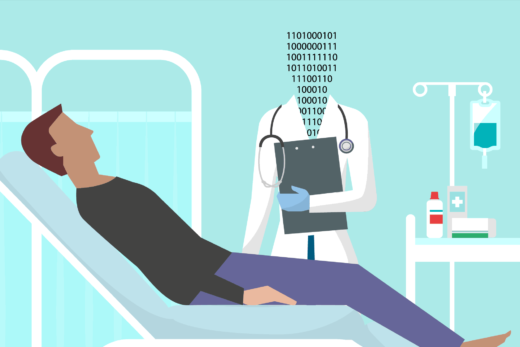Everyone is familiar with Uber as disruptive. But they couldn’t have existed 10-plus years ago, without smartphones, GPS, online payments--they connected the dots.
We all want that ease and transparency of use that we’re used to with Uber. And we’re seeing that kind of mindset come not just to millennials but to older folks who want access to their clinical data and doctor. There are several companies that have launched apps where you press a button and a doctor will come to you within three hours. Uber itself did a pilot in New York where you press a button and a nurse will come and give you a flu shot. This ease-of-access mindset is coming across in many parts of health care, including delivering your drugs, whether it's by Uber, Lyft or drone.
The Potential of Digital Health Data
We’re in this age of exponential data, but how do you make it useful to you as a consumer, patient and physician? A lot of digital devices get left in a drawer after a month or so; the trick is to make them engaging.
We practice sick care today, spending most of our time and money on folks who already have disease. But we can really move to more proactive, continuous health care using some of these tools.
In the future we’ll have individualized check engine lights. Your information will be synthesized so that a warning light can say, "Hey, time to come in for a checkup before you blow a gasket."
Digital Mental Health Tools
With some wearables and other technologies we can now get a pulse on our behaviors. Right now I’m wearing a couple of devices that track my sleep. I have a ring that can do this; I have a sensor on my mattress. Just getting insight into how you sleep can have a huge impact on health and wellness over the long term.
It’s the same thing for depression and anxiety. We’re seeing companies that can be a platform for mental health progression. For example, for bipolar patients, if you’re depressed and not moving much and staying in the house, some of these new platforms allow you to access your care team and your family, so you can get a digital hug when you might need one.
Virtual and Augmented Reality
Physicians today spend twice as much time typing in their medical records than they do with patients. So one of the best applications is using Google Glass or a similar product so physicians can see their patients and view data but have someone else act as a virtual scribe.
We’re seeing now how Oculus Rift can help medical students learn anatomy, allowing them to fly through the heart or the brain. We’re seeing ways to use VR to treat burn patients who have undergone painful surgeries; they're put into a cold environment where they get to throw snowballs, and it diminishes their pain and their need for opiates. And kids with autism can now put on Google Glass and learn to recognize facial emotions.
Health Screening Tools
Part of the future will be to use new screening tools: app-based eye-tracking devices, blood-based diagnostics, brain scans that might pick up dementia 10 or 15 years early. There are drugs in development that might stop or reverse plaques when you’re at stage 0, before you have symptoms.
Even with your 23andme data, primary care doctors could gain some insights--when to screen you or what statin drugs may work best for you, based on your pharmacogenomics. The challenge is a lot of this information doesn’t flow to your physicians; they’re not incentivized to use it, and in some cases they're dis-incentivized.
Health Care vs. Technology Care
Folks talk about robot physicians or the app taking over your medical care. I think it’s going to be more of a blend, not just AI but IA, intelligence augmentation. So in fields like radiology or dermatology or pathology, where clinicians are trained to see patterns, now machine learning can arguably do that faster and better, and that can augment a primary care doctor in screening you for melanoma, for example.
We’re seeing the ability to do triage with chatbots, which you might access from your phone and help you do the first steps. I’ve got a few medical tricorders, inspired by "Star Trek," with me. So at home or in your pocket you can literally pull down advanced vital signs that synch up with your phone and connect to your clinicians, and AI agents can help you understand where you are in your baseline and the way things are moving.
We don’t need to replace doctors, but maybe every visit doesn’t need to require you to take off half a day of work, sit in the waiting room and fill out the same form. You might use your smartphone for a follow-up appointment to look at a wound from surgery, or to check on a suspicious skin lesion. As cost pressures go, we’ll be seeing more and more payment for some of these telehealth platforms.
Pediatrics and Technology
There's a lot of new tech coming for pregnant women and children. A connected otoscope can enable you to track kids with ear infections at home, so you don't have to drag them back to the doctor. We’re seeing sensored cribs or infant ankle bracelets, sort of a Fitbit for babies, which can help reassure worried parents or enable a physician to send a child home earlier when they're at risk of SIDS or asthma.
